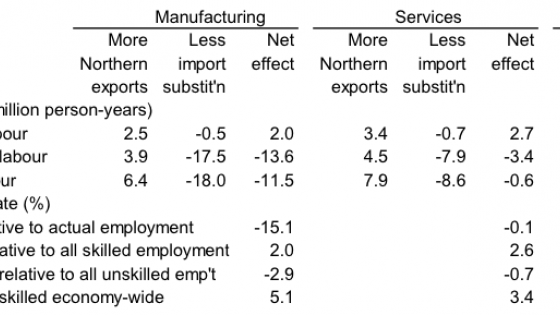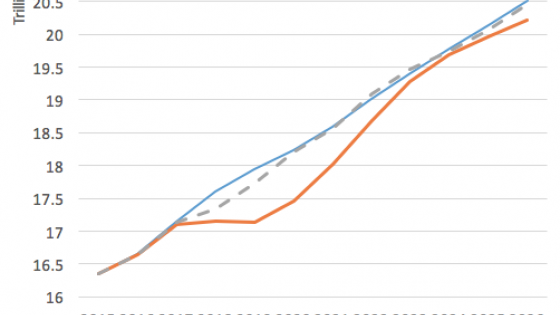With approval ratings hovering around 30%, candidate Donald Trump went big on anti-globalisation economic nationalism. In a speech on 28 June 2016 in Monessen, Pennsylvania, he told his audience that "globalisation has made the financial elite who donate to politicians very, very wealthy ... but it has left millions of our workers with nothing but poverty and heartache."
This apocalyptic rhetoric caught the imagination of many middle-class Americans who feel that trade – especially imports from low-wage nations like Mexico and China – is why they have seen their incomes stagnate for two decades. Trump understood that the middle is being taken out of the middle class, and that globalisation has been an important cause of it.
In office, President Trump has continued the assault on globalisation. In this he has a sympathetic and experienced ally. Robert Lighthizer, who leads his trade team as the United States Trade Representative (USTR), is instinctively protectionist. He was Deputy US Trade Representative during the Reagan administration, when the fashion was for “managed trade” to protect US industries. Lighthizer helped negotiate quotas on imports of cars, textiles, colour TVs, semi-conductors and even mushrooms.
The USTR believes that this type of protectionism is in the great tradition of conservative American statesman. In 2008, he foreshadowed the Trumpian rhetoric, accusing "liberal elites" of being the irresponsible advocates (and beneficiaries) of globalisation. "Modern free traders," he wrote, "embrace their ideal with a passion that makes Robespierre seem prudent".
The two other members of Trump’s trade team are no less protectionist, if less experienced as dealmakers in the 3D chess game of trade negotiation. Wilbur Ross, the Secretary of Commerce, built a fortune restructuring struggling companies in 19th century industries like steel. Peter Navarro, the Director of the White House National Trade Council, literally wrote the book on Trump-era opposition to globalisation. Death by China gets to the point in its first sentence: "Unscrupulous Chinese entrepreneurs are flooding world markets with a range of bone-crushing, cancer-causing, flammable, poisonous, and otherwise lethal products, foods, and drugs", he says. And then he made a movie out of the book.
Behind the bombast, President Trump and his trade team have raised an important problem. But when they try to solve it, all three (four, including the president) seem stuck in the last century. In short, Trump’s trade strategy is treating a real problem with the wrong medicine; it’s like treating brain cancer with aspirin.
No one on the Trump trade team seems to grasp how radically the world of trade changed during the 1990s with the growth of global value chains between rich and poor nations, especially between the US and China.
Lighthizer and Ross in particular built their careers negotiating for, and investing in, 20th century industries such as the steel sector, and perhaps because of that they have misdiagnosed the problem. They all seem to think that the 20th century industrial protectionism can cure America’s 21st century industrial problems. It's no accident that Trump's speech took place in an aluminium recycling facility.
President Trump himself tends to see globalisation as a zero-sum game, in which a Chinese win is a US loss. He repeatedly insists that a trade deficit means the US is getting ripped off, when in fact it means US firms and consumers are getting real goods for financial promises. In his "poverty and hearthache" speech, he told the crowd who to blame for their problems. "China’s entrance into the World Trade Organization has enabled the greatest jobs theft in history", he said.
Resurrecting last century's protectionism might still save a few thousand jobs in sunset sectors like steel, but ripping up trade agreements and raising tariffs won’t help the bulk of American workers get back good factory jobs. In fact, old-fashioned protection is more likely to harm them than help them.
Today’s globalisation is knowledge led, not trade led. From the 1990s, radically lower communication costs allowed US firms to offshore production to low-wage nations. But large chunks of technical, marketing and managerial knowhow were offshored too. It was “knowledge offshoring” that changed the game.
US workers today are not competing with low-wage foreign labour, foreign capital, and foreign technology as they did when Lighthizer was making his Reagan-era protectionist deals. They are competing with a near unbeatable combination of low-wage foreign labour and US knowhow. This means that American products are not made in the US. They are made in a location we can call "factory North America", and they compete with goods made in "factory Asia" and "factory Europe".
Tariffs don’t work in a world where we have to import to export
In response, the US trade team wants to build a wall made of tariffs. But trying to impose tariffs on imports without stemming the free flow of ideas, copyrights, intellectual property, and knowledge across those borders is like building the wall in the middle of the factory.
So, this trade war will turn the US into a high-cost island for industrial inputs. Some firms will reshore production of products aimed at US consumers. But the same tariffs will also encourage them to offshore production of products for export markets so they can remain competitive with Japanese, German, and Chinese producers.
Now look at this from the point of view of the workers in Monessen, Pennsylvania. Tariffs cannot help them, because today they need to compete with robots at home as well as low-wage workers abroad. Shutting down imports is far more likely to create work for those robots than bring back factory jobs for ordinary people.
A more rational reaction to this crisis might still include protectionism, but not of the Lighthizer-Ross-Navarro sort. When the US and Japan were locked in a similar conflict in the 1980s, the US threatenedprotection with the Super-301 bill and used that “big stick” in the background to negotiate with Japan on its structural impediments (in the so-called Structural Impediments Initiative). Trump slapped tariffs on every partner, including China, without having a clear strategy for addressing the real concerns.
Protect workers not jobs
Twenty-first century protectionism should protect individual workers, not individual jobs. It can do this by providing retraining, lifelong education, mobility support, income support, and active regional policy, rather than using tariffs and quotas.
This is not a new idea. In the great post-war liberalisation, government programmes helped the middle classes to seize new opportunities. It gave them affordable education, strong unions, social security and progressive income taxes. But in the last two decades this social contract has been torn up while globalisation advanced. We need to restore of this social contract.
Damaging international supply chains by imposing tariffs and starting trade wars will hasten the shift abroad of the jobs that the protectionists are trying to save. Without a new social contract, the poverty and heartache of US workers will only increase.
Richard Baldwin is author of "The Great Convergence: Information Technology and the New Globalisation" published by Harvard University Press.



